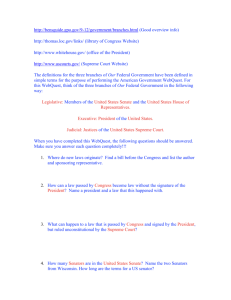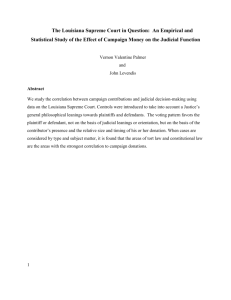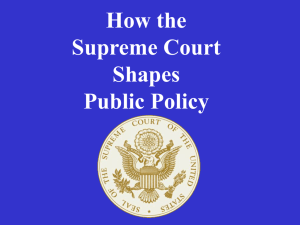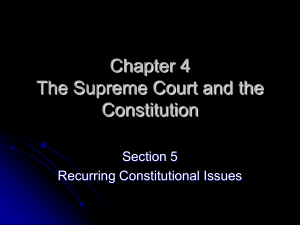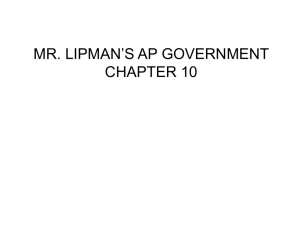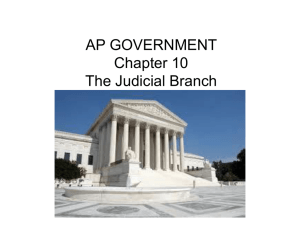Almost Painless Guide to the Judicial Branch
advertisement
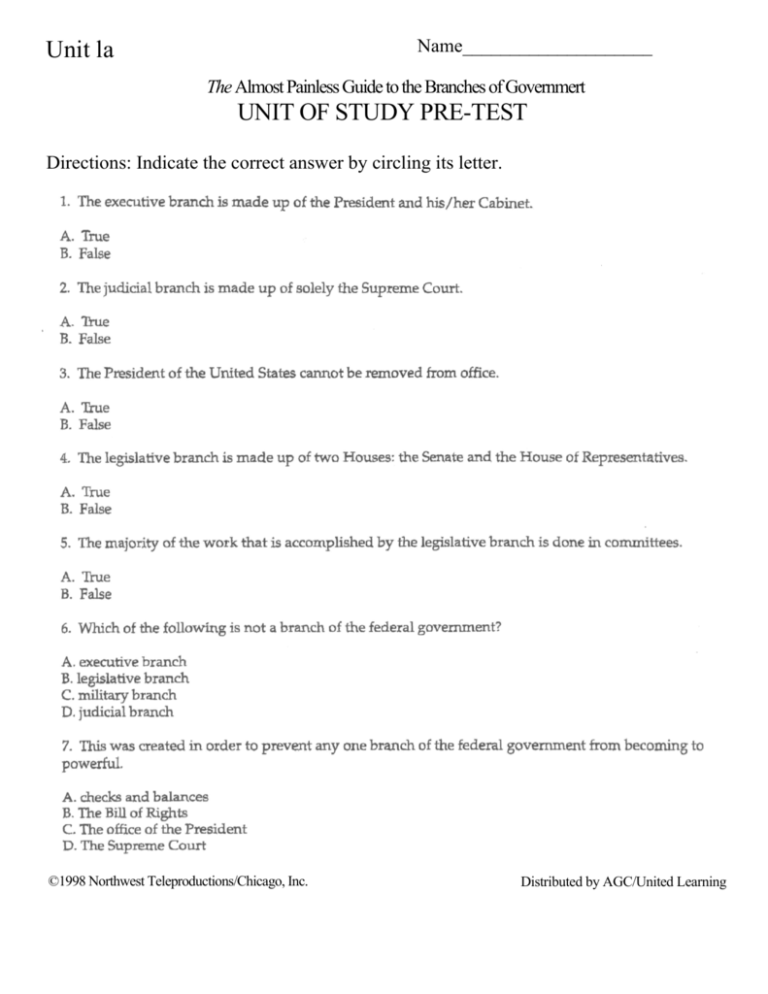
Name____________________ Unit la The Almost Painless Guide to the Branches of Governmert UNIT OF STUDY PRE-TEST Directions: Indicate the correct answer by circling its letter. ©1998 Northwest Teleproductions/Chicago, Inc. Distributed by AGC/United Learning Unit la Name________________ The Almost Painless Guide to the Branches of Government UNIT OF STUDY PRE-TEST ©1998 Northwest Teleproductions/Chicago, Inc, Distributed by AGC/United Leaning Unit 2 Name____________________ The Almost Painless Guide to the Branches of Government POLITICAL CARTOON Directions: Analyze the political cartoon below and answer the questions in the spaces provided. Use the back of the sheet if necessary. ©1998 Northwest Teleproductions/Chicago, Inc. Distributed by AGC/United Learning Name___________________ Unit 3 The Almost Painless Guide to the Branches of Government CHECKS AND BALANCES 1. In the space provided, write the name of the branch of government that has each of the following specific responsibilities. _________ A. To write laws and establish policies for the government. __________ B. To carry out administer, and enforce the policies of the government. _________ C. To interpret the laws of the government. 2. In the space provided, write the name of the branch of government next to the body of people that elects them. __________ A. Elected in a national election using an electoral college. __________ B. Elected in a state election by residents of that state. __________ C. Members of this branch are appointed not elected. 3. In the space provided, write the name of the the branch of government next to the appropriate length of term. _________ A. Length of term is for life. _________ B. Length of term is for four years. _________ C. Length of term is for either two or four years. 4. How do all of these differences help to create a system of checks and balances? Name_____________________ Unit 4 The Almost Painless Guide to the Branches of Government MORE CHECKS AND BALANCES Directions: Listed below are some of the checks and balances of the three branches of government. In the spaces provided write "E" if it is a power possessed by the executive branch, "L" if it is a power possessed by the legislative branch, or "J" if it is a power possessed by the judicial branch. ©1998 Northwest Teleproductions/ Chicago, Inc. Distributed by AGC/United Learning Name________________ Unit 5 The Almost Painless Guide to the Branches of Government STILL MORE CHECKS AND BALANCES Directions: Read the following scenario. What actions might the executive, legislative, and judicial branches take if such a scenario were to occur. Congress has passed a law making all guns illegal. The House of Representatives approved the law by a vote of 415 to 20. The Senate approved the law by a vote of 80 to 20. The President is strongly against this law. 1. Possible actions taken by the executive branch: 2. Possible actions taken by the legislative branch: 3. Possible actions taken by the judicial branch: Name___________________ Unit 6a The Almost Painless Guide to the Branches of Government UNIT OF STUDY POST-TEST True or False Directions: Indicate if each statement is true ("T") or false ("F")- (1 point each) ©1998 Northwest Teleproductions/Chicago, Inc. Distributed by AGC/United Learning Name___________________ Unit 6b The Almost Painless Guide to the Branches of Government UNIT OF STUDY POST-TEST ©1998 Northwest Teleproductions/Chicago, Inc. Distributed by AGC/United Learning Name__________________ Unit 6c The Almost Painless Guide to the Branches of Government UNIT OF STUDY POST-TEST ©1998 Northwest Teleproductions/Chicago, Inc. Distributed by AGC/United Learning Name__________________ Unit 6d The Almost Painless Guide to the Branches of Government UNIT OF STUDY POST-TEST ©1998 Northwest Teleproductions/Chicago, Inc. Distributed by AGC/United Learning Name___________________ Unit 6e The Almost Painless Guide to the Branches of Government UNIT OF STUDY POST-TEST ©1998 Northwest Teleproductions/Chicago, Inc. Distributed by AGC/United Learning Unit 6f Name________________ The Almost Painless Guide to the Branches of Government UNIT OF STUDY POST-TEST _ Unit 6h Name———————————————— The Almost Painless Guide to the Branches of Government UNIT OF STUDY POST-TEST 62. How is the appointment of a Supreme Court justice an example of checks and balances? (6 Points) 63. If a bill were to passed by Congress that legalized prayer in schools, what would be some possible actions that the (1) Executive Branch, (2) Legislative Branch, and (3) Judicial Branch could take concerning this bill? (9 points) Essay Directions: Answer the following question as completely as possible. Make sure that you use specific examples to back up your thoughts. (20 points) 64. The Preamble of the Constitution starts off with the words "We the People.." How do the three branches of government embody this idea? ©1998 Northwest Teleproductions/Chicago, Inc. Distributed by AGC/United Learning THE JUDICIAL BRANCH ©1998 Northwest Teleproductions/Chicago, Inc. Distributed by AGC/United Learning Name______________________________ 1 The Almost Painless Guide to the Branches of Government THE JUDICIAL BRANCH PRE-TEST Directions: Indicate the correct answer by circling it. 1. Supreme Court justices are elected by popular vote. A. True B. False 2. Supreme Court justices have an eight-year term of office. A. True B. False 3. The Supreme Court can “check” Congress and the President by declaring a law “unconstitutional.” A. True B. False 4. Amendments are used to change the Constitution. A. True B. False 5. The judicial branch is made up solely of the Supreme Court. A. True B. False 6. There has never been a women on the Supreme Court. A. True B. False 7. A Supreme Court justice must be at least 30 years of age. A. True B. False 8. A Supreme Court bustice can be impeached. A. True B. False 9. The Supreme Court is the highest court in the United States. A. True B. False 10. In order for a decision to be handed down, all of the Supreme Court justices must agree. A. True B. False ©1998 Northwest Teleproductions/Chicago, Inc. Distributed by AGC/United Learning Name______________________________ 2 The Almost Painless Guide to the Branches of Government THE JUDICIAL BRANCH VIDEO QUIZ 1. There are nine Supreme Court justices. A. True B. False 2. The Supreme Court is the highest court in the United States. A. True B. False 3. There are no laws that are reserved for the state governments. A. True B. False 4. Congress does not have the means to “check” the Supreme Court A. True B. False 5. The term of office for a Supreme Court justice is for life. A. True B. False 6. The __________________ nominates individuals to be Supreme Court justices, and the __________________ approves them. A. President/Congress B. Congress/President C. Congress/Supreme Court D. President/Supreme Court 7. One of the duties of the _____________________ is to insure that laws created by Congress are Constitutional. A. Congress B. President C. Pentagon D. Supreme Court 8. The outcome of a Supreme Court decision is determined by a A. 1/2 vote. B. majority vote. C. 3/4 vote. D. unanimous vote. 9. Which of the following is not a lower court in the Federal Court system? A. US Court of Appeals B. US District Courts C. US Grand Jury Court D. US Claims Court 10. The means by which the Supreme Court has the authority to rule on the Constitutionality of federal and state laws is called A. appeals review. B. a supreme decision. C. ultimate authority. D. judicial review. ©1998 Northwest Teleproductions/Chicago, Inc. Distributed by AGC/United Learning Name______________________________ 3 The Almost Painless Guide to the Branches of Government THE JUDICIAL BRANCH VOCABULARY judicial branch - one of the three branches of government; it has the power to interpret the laws and apply these laws to court cases judicial review - power of the courts to determine the constitutionality of the actions of the legislative and executive branches of government jurisdiction - legal authority of the courts original jurisdiction - authority of a court to hear and decide a case for the first time appellate jurisdiction - authority of a court to review decisions (hear appeals) of a lower court Bill of Rights - the first ten amendments to the United States Constitution Supreme Court - the highest court in the land; it is the only court created by the United States Constitution and it is the final interpreter of the United States Constitution ©1998 Northwest Teleproductions/Chicago, Inc. Distributed by AGC/United Learning Name______________________________ 4 The Almost Painless Guide to the Branches of Government THE JUDICIAL BRANCH DISCUSSION QUESTIONS 1. How can the Constitution be changed? 2. Why is our government called a “federal government?” 3. How is the power of the Supreme Court “checked” by the other two branches of government? 4. How does the Supreme Court check the other two branches of government? 5. What is the length of term for a Supreme Court Justice? 6. What are the other courts that make up our federal court system? 7. What is “judicial review?” 8. How many justices serve on the Supreme Court at the current time? What is the significance of this number? 9. How do original and appellate jurisdiction play a role in the Supreme Court? 10. What are the requirements of a Supreme Court justice? ©1998 Northwest Teleproductions/Chicago, Inc. Distributed by AGC/United Learning Name______________________________ 5a The Almost Painless Guide to the Branches of Government THE JUDICIAL BRANCH YOU BE THE JUDGE Directions: Using the data presented on blackline master #5b, answer the folloing questions in the spaces provided. Use the back of the sheet if necessary. 1. What influence or effect has the political affiliation of the President had upon the judicial branch? Explain this influence. 2. Compare and contrast the gender make-up of the judicial branch to that of the nation. What conclusion(s) can be drawn? 3. Compare and contrast the ethnicity of the executive branch to that of the nation. What conclusion(s) can be drawn? 4. Defend or refute the following statement: “The judicial branch accurately represents the concept of `We the People.’” ©1998 Northwest Teleproductions/Chicago, Inc. Distributed by AGC/United Learning Name______________________________ 5b The Almost Painless Guide to the Branches of Government THE JUDICIAL BRANCH YOU BE THE JUDGE Directions: In this activity, you will be asked to compare statistical data of the judicial branch to other groups. The objective of this activity is to analyze how the judicial branch reflects the demographic profile of the American population. Use the data below to answer the questions on blackline master #5a. Statistics of the Judicial Branch (1976-1972) Political Affiliation Gender Ethnicity Statistics of the Executive Branch (1976-1992) Political Affiliation Statistics of the American Populace (1990) Gender Ethnicity Note: Total may not add up to 100% due to rounding of numbers. ©1998 Northwest Teleproductions/Chicago, Inc. Distributed by AGC/United Learning Name______________________________ 6a The Almost Painless Guide to the Branches of Government THE JUDICIAL BRANCH POST-TEST True/False and Multiple Choice Directions: Identify the correct answer to each question by circling its letter. 1. Supreme Court justices are voted on by popular vote. A. True B. False 2. Supreme Court justices have an eight-year term of office. A. True B. False 3. Once the Supreme Court rules on an issue, that issue can never be brought before the court again. A. True B. False 4. Amendments are used to change the Constitution. A. True B. False 5. The judicial branch is made up solely of the Supreme Court. A. True B. False 6. The Constitution calls for a Supreme Court. A. True B. False 7. A Supreme Court justice can be impeached. A. True B. False 8. A women has never been a Supreme Court justice. A. True. B. False. 9. The Supreme Court is the highest court in the United States. A. True B. False 10. Congress does not have the means to “check” the Supreme Court A. True B. False 11. The __________________ nominates individuals to be Supreme Court justices, and the __________________ approves them. A. President/Congress B. Congress/President C. Congress/Supreme Court D. President/Supreme Court 12. One of the duties of the _____________________ is to insure that laws created by Congress are Constitutional. A. Congress B. President C. Pentagon D. Supreme Court ©1998 Northwest Teleproductions/Chicago, Inc. Distributed by AGC/United Learning Name______________________________ 6b The Almost Painless Guide to the Branches of Government THE JUDICIAL BRANCH POST-TEST 13. The outcome of a Supreme Court decision is determined by a A. 1/2 vote. B. majority vote. C. 3/4 vote. D. unanimous vote. 14. Which of the following is not a lower court in the Federal Court system? A. US Court of Appeals B. US District Courts C. US Grand Jury Court D. US Claims Court 15. The means by which the Supreme Court has the authority to rule on the Constitutionality of federal and state laws is called A. appeals review. B. a supreme decision. C. ultimate authority. D. judicial review. 16. Which branch of government interprets laws and government policies? A. legislative B. judicial C. executive D. Congressional 17. What is the current number of Supreme Court justices? A. 6 B. 7 C. 9 D. 12 18. Courts with the authority to decide cases for the first time are said to have A. exclusive jurisdiction. B. appellate jurisdiction. C. original jurisdiction D. concurrent jurisdiction. 19. Which of the following requirements are needed in order to be a Supreme Court justice? I. Be at least 36 years of age II. Be a U.S. citizen III. Be a lawyer IV. Have held political office A. I, II, III, IV C. III, IV B. I, II D. None of the above 20. The person that is the head of the Supreme Court is the A. Chief Justice. B. President. C. Vice President D. Speaker of the House ©1998 Northwest Teleproductions/Chicago, Inc. Distributed by AGC/United Learning Name______________________________ 6c The Almost Painless Guide to the Branches of Government THE JUDICIAL BRANCH POST-TEST Essay Directions: In the space provided below, answer the follow question in a clear and concise manner. Use the back of the sheet if necessary. How does the Judicial Branch and the powers of the Supreme Court reflect the concept of “We the People?” ©1998 Northwest Teleproductions/Chicago, Inc. Distributed by AGC/United Learning EXTENDED LEARNING ACTIVITY - 1 Name______________________________ The Almost Painless Guide to the Branches of Government THE JUDICIAL BRANCH Case Analysis Teacher Instructions 1. Each student should have copies made of Extended Learning Activity Sheets #2-6. 2. Hand out Extended Learning Activity Sheet #2. Have each of the students read the circumstances of Korematsu v. United States. 3. Students should then follow the instructions given on Extended Learning Activity Sheet #3. They will analyze the arguments presented to form an opinion on a constitutional question. 4. Students should use Extended Learning Activity Sheet #4 as a reference tool to help them to write their opinion on the constitutional question. 5. Divide students into cooperative groups of three. Later, these groups will be combined with other groups to form a “Supreme Court” of nine justice, so take this into consideration when organizing the groups. 6. After the students have had an opportunity to write their analyses (Extended Learning Activity Sheet #5), , they should meet within their groups of three to discuss their opinions. Students should record the arguments which they felt were most valid and add any other opinions to their written statement. 7. Students should then be placed in groups of nine that represent the Supreme Court. They should report their opinions on the constitutional question to the group. The group should record the number of people in the Court who sided with Korematsu, and those who sided with the United States. Then, the individuals who decided in the majority should write a combined opinion on why they ruled as they did, and those students in the minority should do the same. 8. Reconvene with the whole class and discuss how each group of nine decided, whether in favor of Korematsu or the United States. Discuss the arguments and the opinions of the students. Then, explain to the students that Supreme Court cases are impacted by the individuals in the court. As a result, Supreme Court decisions can easily be overturned years later. 9. You may want to review the result of the real case on Extended Learning Activity Sheet #6. ©1998 Northwest Teleproductions/Chicago, Inc. Distributed by AGC/United Learning EXTENDED LEARNING ACTIVITY - 2 Name______________________________ The Almost Painless Guide to the Branches of Government THE JUDICIAL BRANCH Case Analysis Korematsu v. United States (1943) Circumstances of the Case On December 7, 1941, the Japanese attacked the United States Navy at Pearl Harbor, Hawaii. Although the United States was not officially fighting in World War II, there was tension between the two countries. The surprise attack at Pearl Harbor caused concern around the United States. Many Americans felt that a similar type of attack could occur on the Pacific Coast, now that the United States had entered the war. President Franklin Delano Roosevelt, on the recommendation of the War Department, reacted to the attack at Pearl Harbor with Executive Order #9066. This order authorized the Secretary of War to evacuate and relocate “all or any persons of Japanese descent” in order to provide “protection against espionage or against sabotage to national defense...” There were approximately 112,000 people of Japanese descent living in the United States at the time, two-thirds of whom were United States citizens, who were evacuated and relocated to isolated regions in the American west. These people were allowed to take only items that they could carry; all other items could be placed in government storage at their own risk. Such people lost homes, businesses, land, and personal belongings during the evacuations. Toyosaburo Korematsu, a Japanese-American citizen, lived near San Francisco, California. He refused to report for relocation. As a result, he was in direct violation of a congressional action, which penalized those who violated the Executive Order. Korematsu was convicted in federal court. He then appealed to a circuit court, but the appeal failed. Finally, the case came before the Supreme Court. ©1998 Northwest Teleproductions/Chicago, Inc. Distributed by AGC/United Learning EXTENDED LEARNING ACTIVITY - 3 Name______________________________ The Almost Painless Guide to the Branches of Government THE JUDICIAL BRANCH Case Analysis Directions: Please read the following arguments from the Korematsu v. United States 1944 Supreme Court case carefully. As your analyzing the arguments consider which ones you believe to be most important and valid. The Constitutional Question Did the President and Congress go beyond their war powers by implementing exclusion and restricting rights of Americans of Japanese descent? Arguments for Korematsu 1. Executive Order No. 9066 is based on a racial classification. Japanese-Americans were being excluded solely along racial lines. Further proof of this exclusion based upon race can be seen in the fact that both German- and Italian-Americans were not placed under such restrictions, even though the United States was at war with both Germany and Italy at the time. This type of racial segregation is illegal under the United States Constitution. 2. Executive Order No. 9066 denied Mr. Korematsu his Fifth Amendment guarantee of liberty and due process. The Fifth Amendment guarantees that a person can be tried for a serious crime only if he or she has been charged with that crime by a grand jury. Under Executive Order No. 9066 ,Mr. Korematsu was never charged with a crime and was never indicted by a grand jury. This is a clear violation of his Fifth Amendment rights. 3. The President never declared martial law in the area. Therefore, the President could not give the military the power to regulate civilians. Arguments for the United States 1. War had been declared by Congress in accordance with the Constitution (Section 8, Clause 11). The President as Commander -In-Chief has the right, according to the Constitution (Section 2, Clause 1), to issue Executive Order No. 9066. 2. Military necessity and the danger of sabotage and espionage made Executive Order No. 9066 necessary. Even though the liberty of some Americans had been denied, national security in times of crisis may outweigh the rights of individuals. 3. The United States was attacked by Japan. Therefore, it was Japan that threatened the West Coast of the United States. It is only rational, then, that people of Japanese descent would be identified as possible spies or saboteurs. ©1998 Northwest Teleproductions/Chicago, Inc. Distributed by AGC/United Learning EXTENDED LEARNING ACTIVITY - 4 Name______________________________ The Almost Painless Guide to the Branches of Government THE JUDICIAL BRANCH Case Analysis The Executive Order was supported by two parts of the Constitution: Section 2 Powers of the President Clause 1. Military powers; Cabinet; pardon The President shall be Commander-In-Chief of the Army and Navy of the United States, and of the militia of the several states, when called into the actual service of the United States Section 8 Powers granted to Congress Clause 10 To define and punish piracies and felonies committed on the high seas and offenses against the laws for nations. Clause 11 To declare war, grant letters of marque and reprisal, and make rules concerning captures on land and water. Clause 15 To provide for calling forth the militia to execute the laws of the Union, suppress insurrections, and repel invasions; 5th Amendment No person shall be held to answer for a capitol or otherwise infamous crime, unless on a presentment or indictment of a grand jury, except in cases arising in the land or naval forces, or in the militia, when in actual service in time of war or public danger. ©1998 Northwest Teleproductions/Chicago, Inc. Distributed by AGC/United Learning EXTENDED LEARNING ACTIVITY - 5 Name______________________________ The Almost Painless Guide to the Branches of Government THE JUDICIAL BRANCH Case Analysis Directions: Using the arguments as well as the source material fromExtended Learning Activity Sheet #4, form an opinion on the constitutional question inolved in Korematsu v. United States. In 25-50 words, state how you would rule on this Constitutional issue if you were a Supreme Court justice. Your opinion should declare Executive Order No. 9066 as either constitutional or unconstitutional. You must then explain this decision. Use the space provided below and the back of the sheet if necessary. ©1998 Northwest Teleproductions/Chicago, Inc. Distributed by AGC/United Learning EXTENDED LEARNING ACTIVITY - 6 Name______________________________ The Almost Painless Guide to the Branches of Government THE JUDICIAL BRANCH Case Analysis Actual Outcome of Korematsu v. United States Supreme Court Decision: In the case of Korematsu v. United States, the Supreme Court ruled, in a 6-3 decision, that Executive Order No. 9066 and the actions by the President and Congress were constitutional. Majority Opinion: The majority opinion was written by Justice Hugo Black. In this opinion, Justice Black focused on the military emergency. He wrote that the prevention of espionage and sabotage was sufficiently urgent and closely enough related to the evacuation to be allowed under the constitution. According to the Court, the “power to protect must be commensurate with the threatened danger.” In addition, the Court discounted the question of racial prejudice, stating that to “cast this case into outlines of racial prejudice, without reference to the real military dangers which were presented, merely confuses the issue.” Ultimately, the Court ruled that “Congress, reposing its confidence in this time of war in our military leaders....., determined that they should have the power to do just this....The need for actions was great, and the time was short. We cannot - by availing ourselves of the calm perspective of hindsight - now say that at that time these actions were unjustified.” Dissenting Opinions: Justices Frank Murphy and Robert Jackson wrote dissenting opinions. Both emphasized the racial discrimination of the evacuations. Justice Murphy referred to the matter as “this legalization of racism.” In addition, Justice Murphy held that the actions taken against Mr. Korematsu and other Japanese-Americans were a depravation of “equal protection of the law as guaranteed by the Fifth Amendment.” Justice Murphy believed that the military should have first proven that a real pressing public danger existed before evacuating Japanese-Americans. ©1998 Northwest Teleproductions/Chicago, Inc. Distributed by AGC/United Learning Distributed by United Learning 1560 Sherman Avenue, Suite 100 Evanston, IL 60201 800-323-9084 www.unitedstreaming.com info@unitedstreaming.com
